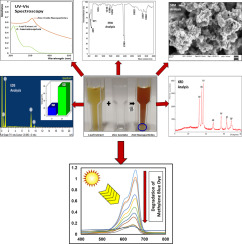当前位置:
X-MOL 学术
›
J. Photochem. Photobiol. B Biol.
›
论文详情
Our official English website, www.x-mol.net, welcomes your
feedback! (Note: you will need to create a separate account there.)
Synthesis, characterization and photocatalytic dye degradation capability of Calliandra haematocephala-mediated zinc oxide nanoflowers.
Journal of Photochemistry and Photobiology B: Biology ( IF 3.9 ) Pub Date : 2019-12-18 , DOI: 10.1016/j.jphotobiol.2019.111760 Ramesh Vinayagam 1 , Raja Selvaraj 1 , Pugazhendhi Arivalagan 2 , Thivaharan Varadavenkatesan 3
Journal of Photochemistry and Photobiology B: Biology ( IF 3.9 ) Pub Date : 2019-12-18 , DOI: 10.1016/j.jphotobiol.2019.111760 Ramesh Vinayagam 1 , Raja Selvaraj 1 , Pugazhendhi Arivalagan 2 , Thivaharan Varadavenkatesan 3
Affiliation

|
An environmentally sound approach towards the green synthesis of zinc oxide nanostructures has been achieved with an aqueous extract of Calliandra haematocephala leaves. The nanoparticles were characterized using various analytical techniques to substantiate the structural details. An absorption band at 358 nm corresponds to the formation of zinc oxide nanoparticles. Scanning electron microscopy revealed the nanoflower morphology of the nanoparticles. Energy dispersive spectral analysis portrayed the strong presence of zinc and oxygen, while X-ray diffraction showed the nanoparticles to conform to hexagonally-formed wurtzite structure. The crystallite size of the nanoflowers was estimated to be 19.45 nm. Vibrational frequencies, typical of zinc‑oxygen and other functional groups, were revealed using Fourier transform infrared spectroscopy. BET analysis revealed that the pores were of mesoporous nature with an estimated specific surface area of 9.18 m2/g. The photocatalytic nature of the nanoparticles was established by the degradation of methylene blue (MB) dye, under solar radiation. Up to 88% degradation was achieved in a duration of 270 min. Kinetic data from the studies proved that the reaction was compliant with first-order model, with rate constant as 0.01 min-1. The study illustrated the synthesis of zinc oxide nanoparticles using a novel source, viz., the leaves of C. haematocephala.
中文翻译:

Calliandra haematocephala介导的氧化锌纳米花的合成,表征和光催化染料降解能力。
用Calliandra haematocephala叶子的水提取物已经实现了一种绿色合成氧化锌纳米结构的无害环境的方法。使用各种分析技术表征纳米颗粒,以证实结构细节。358 nm处的吸收带对应于氧化锌纳米颗粒的形成。扫描电子显微镜揭示了纳米颗粒的纳米花形态。能量色散光谱分析描绘了锌和氧的强烈存在,而X射线衍射显示纳米粒子符合六角形纤锌矿结构。纳米花的微晶尺寸估计为19.45nm。使用傅立叶变换红外光谱法揭示了典型的锌-氧和其他官能团的振动频率。BET分析表明,这些孔具有介孔性质,估计比表面积为9.18 m2 / g。纳米粒子的光催化性质是通过在太阳辐射下降解亚甲基蓝(MB)染料来建立的。在270分钟的时间内,降解率高达88%。研究的动力学数据证明,该反应符合一级模型,速率常数为0.01 min-1。该研究说明了使用新型来源,即C. haematocephala的叶子合成氧化锌纳米颗粒的方法。在270分钟的时间内,降解率高达88%。研究的动力学数据证明,该反应符合一级模型,速率常数为0.01 min-1。该研究说明了使用新型来源,即C. haematocephala的叶子合成氧化锌纳米颗粒的方法。在270分钟的时间内,降解率高达88%。研究的动力学数据证明,该反应符合一级模型,速率常数为0.01 min-1。该研究说明了使用新型来源,即C. haematocephala的叶子合成氧化锌纳米颗粒的方法。
更新日期:2019-12-19
中文翻译:

Calliandra haematocephala介导的氧化锌纳米花的合成,表征和光催化染料降解能力。
用Calliandra haematocephala叶子的水提取物已经实现了一种绿色合成氧化锌纳米结构的无害环境的方法。使用各种分析技术表征纳米颗粒,以证实结构细节。358 nm处的吸收带对应于氧化锌纳米颗粒的形成。扫描电子显微镜揭示了纳米颗粒的纳米花形态。能量色散光谱分析描绘了锌和氧的强烈存在,而X射线衍射显示纳米粒子符合六角形纤锌矿结构。纳米花的微晶尺寸估计为19.45nm。使用傅立叶变换红外光谱法揭示了典型的锌-氧和其他官能团的振动频率。BET分析表明,这些孔具有介孔性质,估计比表面积为9.18 m2 / g。纳米粒子的光催化性质是通过在太阳辐射下降解亚甲基蓝(MB)染料来建立的。在270分钟的时间内,降解率高达88%。研究的动力学数据证明,该反应符合一级模型,速率常数为0.01 min-1。该研究说明了使用新型来源,即C. haematocephala的叶子合成氧化锌纳米颗粒的方法。在270分钟的时间内,降解率高达88%。研究的动力学数据证明,该反应符合一级模型,速率常数为0.01 min-1。该研究说明了使用新型来源,即C. haematocephala的叶子合成氧化锌纳米颗粒的方法。在270分钟的时间内,降解率高达88%。研究的动力学数据证明,该反应符合一级模型,速率常数为0.01 min-1。该研究说明了使用新型来源,即C. haematocephala的叶子合成氧化锌纳米颗粒的方法。











































 京公网安备 11010802027423号
京公网安备 11010802027423号